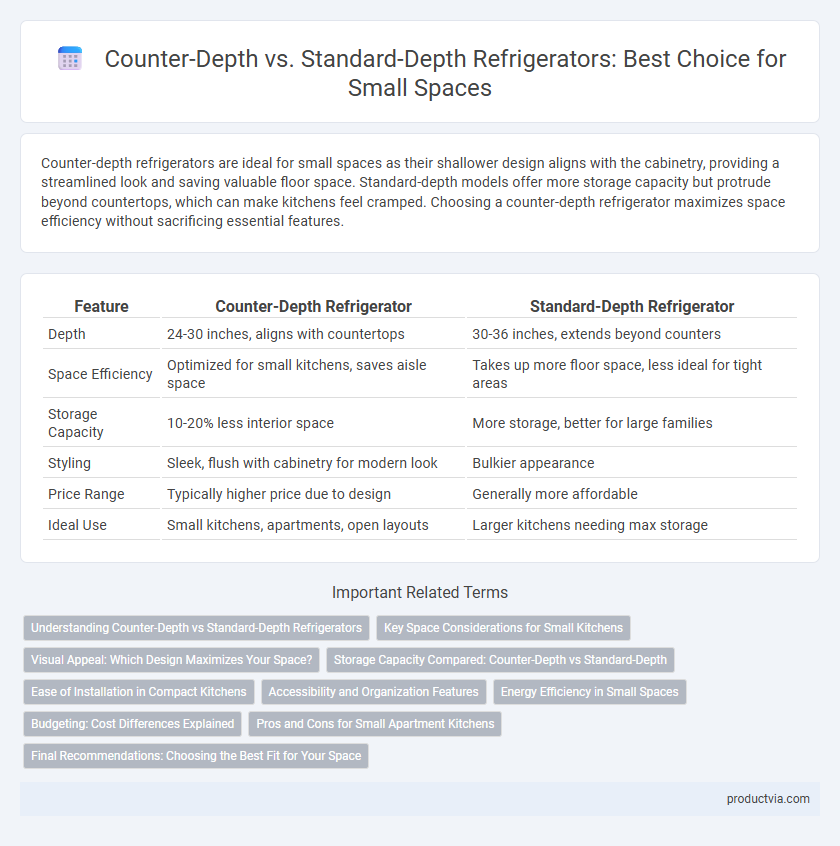Counter-depth refrigerators are ideal for small spaces as their shallower design aligns with the cabinetry, providing a streamlined look and saving valuable floor space. Standard-depth models offer more storage capacity but protrude beyond countertops, which can make kitchens feel cramped. Choosing a counter-depth refrigerator maximizes space efficiency without sacrificing essential features.
Table of Comparison
| Feature | Counter-Depth Refrigerator | Standard-Depth Refrigerator |
|---|---|---|
| Depth | 24-30 inches, aligns with countertops | 30-36 inches, extends beyond counters |
| Space Efficiency | Optimized for small kitchens, saves aisle space | Takes up more floor space, less ideal for tight areas |
| Storage Capacity | 10-20% less interior space | More storage, better for large families |
| Styling | Sleek, flush with cabinetry for modern look | Bulkier appearance |
| Price Range | Typically higher price due to design | Generally more affordable |
| Ideal Use | Small kitchens, apartments, open layouts | Larger kitchens needing max storage |
Understanding Counter-Depth vs Standard-Depth Refrigerators
Counter-depth refrigerators offer a streamlined fit for small kitchens by aligning with the edge of countertops, maximizing floor space without sacrificing width. Standard-depth refrigerators extend beyond counters, providing significantly more storage capacity but potentially limiting movement in compact areas. Choosing between counter-depth and standard-depth models depends on balancing space efficiency with storage needs in tight kitchen layouts.
Key Space Considerations for Small Kitchens
Counter-depth refrigerators typically measure 24 to 30 inches deep, aligning with standard countertop depths to save valuable kitchen space, making them ideal for small kitchens with limited floor area. Standard-depth refrigerators range from 30 to 36 inches deep and offer greater storage capacity but can protrude beyond cabinetry, potentially obstructing traffic flow in compact spaces. Choosing between counter-depth and standard-depth models depends on balancing storage needs against spatial constraints, ensuring efficient movement and a streamlined kitchen layout.
Visual Appeal: Which Design Maximizes Your Space?
Counter-depth refrigerators offer a sleek, built-in look by aligning flush with cabinetry, enhancing visual appeal in small kitchens without protruding into walkways. Standard-depth models provide greater storage capacity but often extend beyond counters, making confined spaces appear cluttered and cramped. Choosing a counter-depth design maximizes spatial harmony and maintains an open, streamlined kitchen aesthetic ideal for limited areas.
Storage Capacity Compared: Counter-Depth vs Standard-Depth
Counter-depth refrigerators offer a sleek, space-saving design ideal for small kitchens but typically provide 10-20% less storage capacity than standard-depth models. Standard-depth refrigerators can store larger quantities and bulkier items, usually ranging from 20 to 30 cubic feet compared to the 15 to 25 cubic feet found in counter-depth units. Opting for standard-depth maximizes storage potential while requiring additional floor space, whereas counter-depth balances aesthetics with moderate capacity for constrained kitchen layouts.
Ease of Installation in Compact Kitchens
Counter-depth refrigerators fit seamlessly into compact kitchens by aligning with the cabinetry, offering easier installation without the need for extra space adjustments. Standard-depth models often require additional clearance, complicating installation in tight spaces due to their protruding design. Choosing counter-depth units simplifies the setup process and maximizes floor space in small kitchen layouts.
Accessibility and Organization Features
Counter-depth refrigerators fit flush with cabinetry, enhancing accessibility in compact kitchens by reducing protrusion into walkways, while standard-depth models offer greater interior capacity but can obstruct traffic flow. Small spaces benefit from counter-depth designs featuring adjustable shelves, door bins, and clear crisper drawers, which optimize organization without sacrificing reachability. Standard-depth refrigerators provide more storage for bulkier items but may require additional effort to access items at the back due to deeper compartments.
Energy Efficiency in Small Spaces
Counter-depth refrigerators fit seamlessly into small kitchens, minimizing energy loss by reducing airflow disturbances around the appliance, which helps maintain consistent internal temperatures and improves energy efficiency. Standard-depth models offer more storage capacity but may consume more energy due to increased internal volume and less optimized placement in tight spaces. Choosing a counter-depth refrigerator in small areas ensures lower energy consumption, contributing to utility savings and an eco-friendly kitchen design.
Budgeting: Cost Differences Explained
Counter-depth refrigerators typically cost more than standard-depth models due to their sleek, space-saving design tailored for small kitchens. Standard-depth refrigerators offer larger capacity at a more affordable price point, making them a budget-friendly option for maximizing storage. Understanding these cost differences helps consumers balance space efficiency with budget constraints when selecting a refrigerator for compact areas.
Pros and Cons for Small Apartment Kitchens
Counter-depth refrigerators fit flush with cabinets, saving precious floor space and creating a streamlined look ideal for small apartment kitchens, but they typically offer less storage capacity compared to standard-depth models. Standard-depth refrigerators provide more interior volume for groceries, which benefits those with larger food storage needs, though they protrude into the kitchen space and may hinder movement in tight areas. Choosing between these options depends on prioritizing kitchen space optimization or maximum storage capacity in compact urban living environments.
Final Recommendations: Choosing the Best Fit for Your Space
Counter-depth refrigerators, typically 24-30 inches deep, provide a sleek, built-in look ideal for small kitchens by saving valuable floor space and improving traffic flow. Standard-depth models, generally 30-34 inches deep, offer more storage capacity but may protrude beyond countertops, potentially overwhelming compact areas. For tight spaces, prioritize counter-depth refrigerators to maximize room efficiency without sacrificing essential cooling performance.
Counter-depth vs Standard-depth for small spaces Infographic

 productvia.com
productvia.com